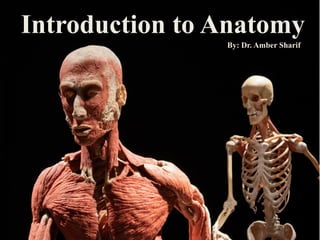
intro to anatomy.pdf
- 1. Human Anatomy Introduction Introduction to Anatomy By: Dr. Amber Sharif
- 2. Session outcomes • By the end of the session students will be able to describe basic anatomical terms • By the end of the session students will be able to use these terms to describe normal movement
- 3. What is Anatomy? • Study of the STRUCTURE of the Human Body • Closely related to PHYSIOLOGY! • Physiology is the study of the FUNCTION of the human body
- 4. Divisions of Anatomy • Gross Anatomy • Structures that can be seen with the eye • Muscles, bones, various organs • Microscopic Anatomy • Structures that cannot be seen with the eye • Need to use a microscope • Cytology = study of cells • Histology = study of tissues
- 5. • Regional Anatomy – study one region of the body at a time and learn everything about the region • Systemic Anatomy – study one body system at a time. This is the approach we will use in this course
- 6. • In addition, Embryology is the study of the embryo and the fetus, that is, the study of prenatal development, whereas the study of congenital malformations is known as Teratology.
- 7. Anatomical Organization • Cells • Tissues • Organs • Organ Systems • Organism
- 8. Organ Systems 1. Integument 2. Skeletal 3. Muscular 4. Nervous 5. Endocrine 6. Cardiovascular 7. Lymphatic 8. Respiratory 9. Digestive 10. Urinary 11. Reproductive
- 9. Directional Terms • Superior : means the part is above another or closer to head (cranial ). Vs. • Inferior: means the part is below another or towards the feet (caudal).
- 10. • Anterior: means towards the front (the eyes are anterior to the brain) - [ventral]. Vs. • Posterior: means toward the back (the pharynx is posterior to the oral cavity) - [dorsal].
- 11. • Medial: relates to the imaginary midline dividing the body into equal right and left halves (the nose is medial to the eyes). Vs. • Lateral: means towards the side with respect to the imaginary midline (the ears are lateral to the eyes).
- 14. • Ipsilateral: the same side (the spleen and descending colon are ipsilateral ). Vs. • Contralateral: Refers to the opposite side (the spleen and gallbladder are contralateral ).
- 15. • Proximal : is used to describe a part that is closer to the trunk of the body or closer to another specified point of reference than another part (the elbow is proximal to the wrist). Vs. • Distal: it means that a particular body part is farther from the trunk or farther from another specified point of reference than another part (fingers are distal to the wrist).
- 16. • Superficial: means situated near the surface. Peripheral also means outward or near the surface. Vs. • Deep: is used to describe parts that are more internal .
- 18. Regional Terms • Axial part : includes the head, neck, and trunk. • Appendicular part : Includes the limbs which are attached to the body's axis.
- 19. 19
- 21. Terms to describe movements Occurring at Various Joints 1. Flexion : Flexion is the movement where similar surfaces come nearer to each other reducing the angle between them. ex: Bending of fore arm near elbow 2. Extension: It is the movement causing similar surfaces to go apart. It is opposite to flexion. ex : Straightening of bent fore arm.
- 22. 3. Adduction: It is the movement bringing the limb towards mid line. 4. Abduction: It is the movement taking the limb away from the mid line. 5. Rotation: It is the movement around central axis involving 360 6. Medial rotation : It is rotation towards medial direction
- 23. 7. Lateral rotation: Rotation towards lateral direction is called lateral direction 8. Circumduction: It is the movement involving flexion, abduction, extension and adduction occurring in sequence